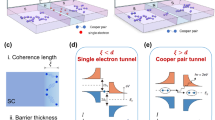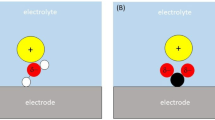Abstract
Non-equilibrium Green's functions (NEGF) formalism combined with extended Hückel (EHT) and charging model are used to study electrical conduction through single-molecule junctions. The analyzed molecular complex is composed of the asymmetric 1,4-Bis((2′-para-mercaptophenyl)-ethinyl)-2-acetyl-amino-5-nitrobenzene molecule symmetrically coupled to two gold electrodes. Owing to this model, the accurate values of the current flowing through such junctions can be obtained by utilizing basic fundamentals and coherently deriving model parameters. Furthermore, the influence of the charging effect on the transport characteristics is emphasized. In particular, charging-induced reduction of conductance gap, charging-induced rectification effect and charging-generated negative value of the second derivative of the current with respect to voltage are observed and examined for the molecular complex.
Similar content being viewed by others
References
W. Tian, S. Datta, S. Hong, R. Reifenberger, J. I. Henderson and C. P. Kubiak: “Conductance spectra of molecular wires”, J. Chem. Phys., Vol. 109(7), (1998), pp. 2874–2882
M.A. Reed, C. Zhou, M.R. Deshpande, C.J. Muller, T.P. Burgin, L. Jones II and J.M. Tour: “The electrical measurement of molecular junctions”, Ann. N.Y. Acad. Sci., Vol. 852, (1998), pp. 133–144.
C. Kergueris, J.-P. Bourgoin, D. Esteve, C. Urbina, M. Magoga and C. Joachim: “Electron transport through a metal-molecule-metal junction”, Phys. Rev. B, Vol. 59(19), (1999), pp. 12505–12513.
J. Reichert, R. Ochs, D. Beckmann, H.B. Weber, M. Mayor and H.V. Löhneysen: “Driving current through single organic molecules”, Phys. Rev. Lett., Vol. 88(17), (2002), pp. 176804.
B. Xu and N.J. Tao: “Measurement of single-moleculer resistance by repeated formation of molecular junctions”, Science, Vol. 301, (2003), pp. 1221–1223.
Y. Wada: “A prospect for single molecule information processing devices”, Pure Appl. Chem., Vol. 71(11), (1999), pp. 2055–2066.
C. Joachim, J.K. Gimzewski and A. Aviram: “Electronics using hybrid-molecular and mono-molecular devices”, Nature, Vol. 408, (2000), pp. 541–548.
A. Nitzan and M.A. Ratner: “Electron transport in molecular wire junctions”, Science, Vol. 300, (2003), pp. 1384–1389.
J.R. Heath and M.A. Ratner: “Molecular electronics”, Phys. Today, Vol. 56(5), (2003), pp. 43–49.
A. H. Flood, J.F. Stoddart, D.W. Steuerman and J.R. Health: “Whence molecular electronics?”Science, Vol. 306, (2004), pp. 2055–2056.
S.E. Lyshevski:Nano- and MicroElectromechanical Systems: Fundamentals of Nano-and MicroEngineering, CRC Press, Boca Raton, FL, 2005.
S.T. Pantelides, M. Di Ventra and N.D. Lang: “Molecular electronics by the numbers”, Physica B, Vol. 296, (2001), pp. 72–77.
E.G. Emberly and G. Kirczenow: “Theoretical study of electrical conduction through a molecule connected to metallic nanocontacts”, Phys. Rev. B, Vol. 58(16), (1998), pp. 10911–10920.
L.E. Hall, J.R. Reimers, N.S. Hush and K. Silvebrook: “Formalism, analytical model, and a priori Green's-function-based calculations of the current-voltage characteristics of molecular wires”, J. Chem. Phys., Vol. 112(3), (2000), pp. 1510–1521.
A. Onipko, Y. Klymenko and L. Malysheva: “Conductance of molecular wires: analytical modeling of connection to leads”, Phys. Rev. B Vol. 62(15), (2000), pp. 10480–10493.
S.N. Yaliraki, A.E. Roitberg, C. Gonzalez, V. Mujica and M.A. Ratner: “The injecting energy at molecule/metal interfaces: implications for conductance of molecular junctions from an ab initio molecular description”, J. Chem. Phys. Vol. 111(15), (1999), pp. 6997–7002.
J.M. Seminario, A.G. Zacarias and J.M. Tour: “Theoretical study of a molecular resonant diode”, J. Am. Chem. Soc., Vol. 122, (2000), pp. 3015–3020.
P.S. Damle, A.W. Ghosh and S. Datta: “Unified description of molecular conduction: from molecules to metallic wires”, Phys. Rev. B, Vol. 64, (2001), pp. 201–403.
Y. Xue, S. Datta and M.A. Ratner: “First-principles based matrix Green's function approach to molecular electronic devices: general formalism”, Chem. Phys., Vol. 281, (2002), pp. 151–170.
J. Taylor, M. Brandbyge and K. Stokbro: “Theory of rectification of Tour wires: the role of electrode coupling”, Phys. Rev. Lett., Vol. 89(13), (2002), pp. 138301.
J. Heurich, J.C. Cuevas, W. Wenzel and G. Schön: “Electrical transport through single-molecule junctions: from molecular orbitals to conduction channels”, Phys. Rev. Lett., Vol. 88(25), (2002), pp. 256803.
A.-P. Jauho, N.S. Wingreen and Y. Meir: “Time-dependent transport in interacting and noninteracting resonant-tunneling systems”, Phys. Rev. B, Vol. 50, (1994), pp. 5528–5544.
F. Zahid, M. Paulsson and S. Datta: “Electrical Conduction through Molecules”, In: H. Morkoc (Ed.):Advanced Semiconductors and Organic Nano-Techniques, Academic Press, 2003.
HyperChem 5.1 Pro for Windows, Hypercube Irc., 1997.
A. Ulman: “Formation and structure of self-assembled monolayers”, Chem. Rev., Vol. 96(4), (1996), pp. 1533–1554.
K. Walczak: “The role of quantum interference in determining transport properties of molecular bridges”, Cent. Eur. J. Chem., Vol. 2(3), (2004), pp. 524–533.
G.C. Liang, A.W. Ghosh, M. Paulsson and S. Datta: “Electrostatic potential profiles of molecular conductors”, Phys. Rev. B, Vol. 69(11), (2004), pp. 115302.
K. Walczak: “Charging effects in biased molecular devices”, Physica E, Vol. 25(4), (2005), pp. 530–534.
M. Di Ventra, S.T. Pantelides and N.D. Lang: “Current-induced forces in molecular wires”, Phys. Rev. Lett., Vol. 88(4), (2002), pp. 046801.
Author information
Authors and Affiliations
About this article
Cite this article
Walczak, K., Edward Lyshevski, S. Modeling transport through single-molecule junctions. centr.eur.j.phys. 3, 555–563 (2005). https://doi.org/10.2478/BF02475612
Received:
Accepted:
Issue Date:
DOI: https://doi.org/10.2478/BF02475612




